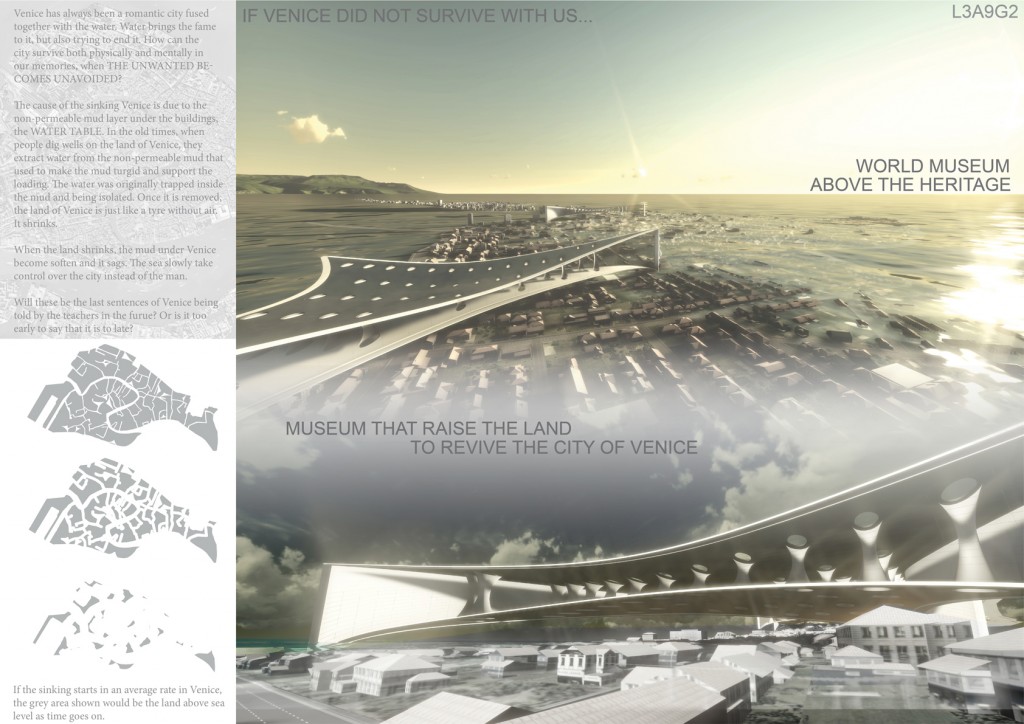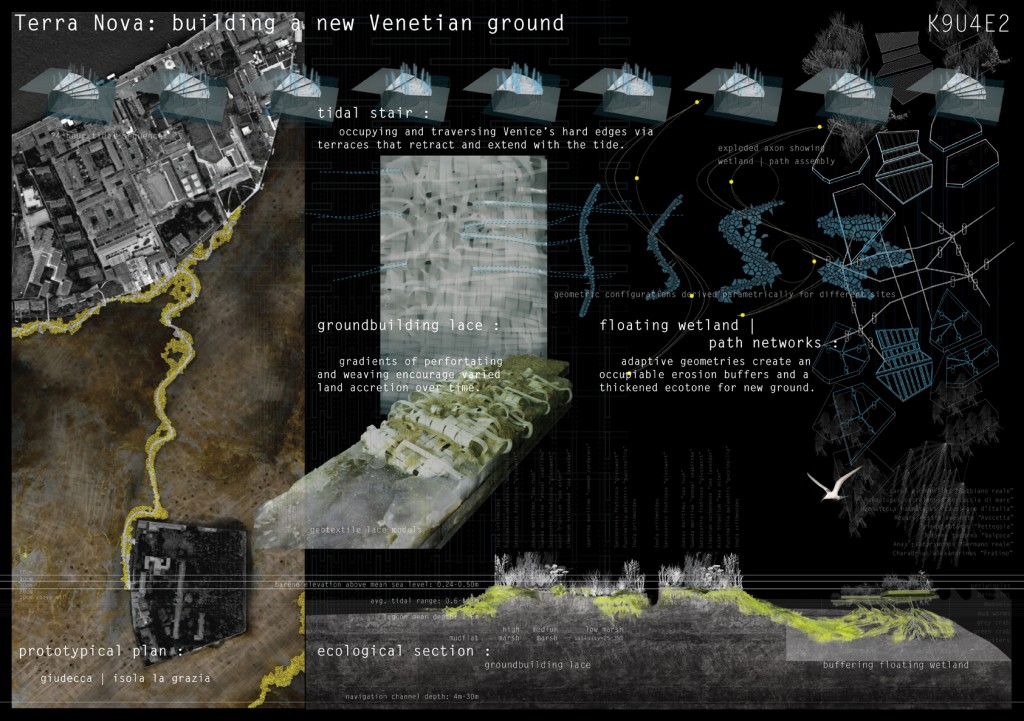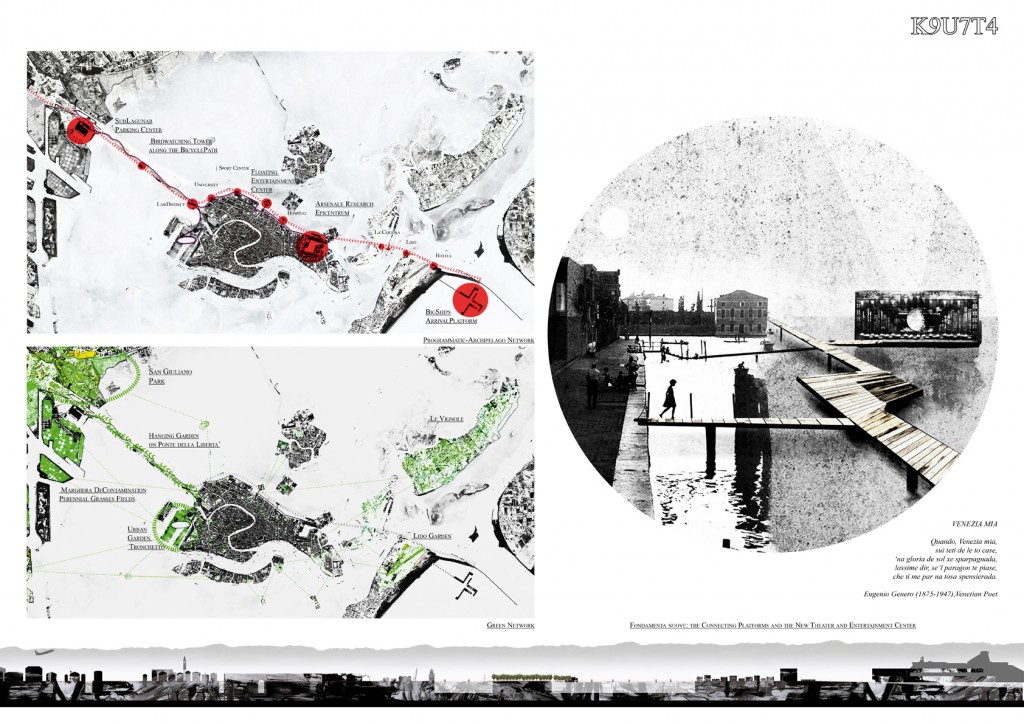Info:
Title: Venice Archipelago - Code: K9U7T4Contest: Venice / 2011
By: Studio Valle
Views: 4925 Likes: 2
Votes:
BJARKE INGELS6 NERI OXMAN7 ELENA MANFERDINI4 MARIA LUDOVICA TRAMONTIN4 BOSTJAN VUGA96.0
Venice Archipelago
VENICE-ARCHIPELAGO “Venice is not that the beauty ambiguous of the adventure,” Simmel writes in the nineteenth century, expressing a romantic idea, blurred vision, that has not reflected in earlier writings, in the Venice “Sumptuous” of the Sansovino and of the Aretino, showing the sign of its decline today. The project starts with three basic issues • the physical elimination of the car bridge (1937) with the expansion of public transport by water bus, subway, bicycle and green landscape. • the protection of cultural resources of the lagoon, the “dead lagoon” in particular, with the elimination of conflicts caused by the port and fishing by moving the port traffic out of the lagoon and stopping the damage caused by fishing. • construction thinning with elimination and replacement of “betrayal” operated in the urban and architectural contest, connected with the project of urban requalification of the front of fondamente nuove/ Arsenal.
The idea of the removal of the connecting way was already present in proposals for Venice master plan in 1964, among that the project “Novissime”, the first real critical to phase out the insular specification of Venice. You can achieve a resolution that the road bridge will become an integral part of the park of San Giuliano system and is destroyed in some places, leaving gaps of water; Tronchetto also will be converted into a public park and garden, a large new parking lot will be located in Marghera.
The lagoon is a body unit of 500 sq. km in the last century that has lost 30% of its surface water and that has entered a deep crisis. The Venice is often drawn as in a pot, a microcosm, with its lagoon; in the decree of Serenissima they wrote:
“The city of the Venetians, by the will of Divine Providence founded on the Water. Water that surrounds and protects this city like walls. Any person who, for whatever reason, causes harm to the public waters will be spared the same penalty as those who had violated the sacred walls of their own Motherland. This decree is valid in perpetuity. ”
The civitas “Rivoalto” born May 25, Sanudo writes, the day when Christ was conceived, Venice is identified with Venus, but also with the Virgin, the divine, elusive, unique, and the time saved from sin. From equidistant from Rome and the empire was founded, its resistance, reluctance to innovative, in the sixteenth century, still Venice refuses again new architecture, but unfortunately accepts the kitsch. It’s never been a city “classic” but an “open form resolved in color and rhythm ..” Venice is alive and its form, the continuous flux of being, holds the privacy of its activities.
The key issue is the lagoon of Venice, which is destined to disappear and become an arm of the sea, because of the depth of the excavation of canals for vessels, Petrols channel, channel Fusina, Channel V. Emanuele, channel Malamocco etc.., the average depth has increased considerably in recent years and there isn’t a unified plan of Venice and its lagoon. The danger of the sea for the preservation of the lagoon has been present since ancient times, see the epigraph of the embankments at the Lido:
UT SACRA AESTUARIA URBIS ET LIBERTATIS SEDES PERPETUUM CONSERVENTUR COLOSSEAS MOLES EX SOLIIDO MARMORE CONTRA MARE PUSUERE CURATORES AQUARUM AN.SAL.MDCCLI AB URBE CON MCCCXXX
The port and dock operations are performed without any control and programming. The lagoon environment is no longer compatible with the port activity of the 21st century, we must move the cargo port and tourist one out of the lagoon, in the Lido waterfront, where will perform the necessary works.
The Arsenal and the “Fondamenta Nuove” have become the heart of this project. A new infrastructure connection must be made along them, the detection of the microcosms, “insulae” equipped; Arsenale, the new center of culture and tourism, is the center of reception and sorting of tourist flows . The rationalization of functional “Fondamenta Nuove” is part of the battle against the corruption of nature. The plan worked in about five hundred a board that receives a first undefined infrastructure through the construction of some buildings, and Contarini between Gritti S. Giustina and S. Francesco della Vigna and the first quarter of two-storey housing, to the Jesuits.
Today this front degraded and abandoned can be retrieved and set up together with the deconstruction of the car bridge the beginning of a process of change in the nature of the city.
Venice is not dying because of tourism, fell to the unwillingness, inability to respond / resolve conflicts created in the twentieth century linked to a logic of accessibility due to the abandonment of insularity, which has unbalanced the balance towards urban square Rome and the mainland. Venice could quickly reach a point of no return. You are witnessing a process in which lagoon is becoming sea and architecture of the city is not true.
The tourism flows are not as high, but are concentrated in a few points destabilizing if it were distributed equally would be a useful resource and not harmful and does not lead to deterioration in quality of life of the inhabitants.
Housing in Venice is influenced by a number of factors that must be resolved, filter tourist flows and improve the quality of life of citizens.
A comprehensive approach where architecture has a central role, through specific urban interventions. Entire urban areas should therefore be redesigned, so-called “treason”.
Vedova knew how to live and understand Venice in a structuralism, in which the sign destroying the object, takes up the substance. We read in his work the desperate moral revolt against the system. As the battle continued in 1974 against the demolition of the “Salons” at Zattere, urban awareness that a society is structured around its spaces of work and not only around monumental one. Vedova is Venice, its ambiguities and conflicts, the strength and the dichotomy of opposing elements.
Info:
Title: Venice Archipelago
Time: 6 giugno 2011
Category: Venice
Views: 4925 Likes: 2
Tags: Divine Providence , Malamocco , Marghera , Rome , Serenissima , Studio Valle , Tronchetto , Venetians , Venice








